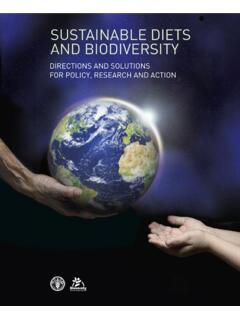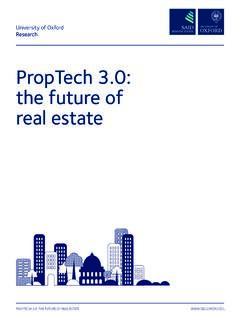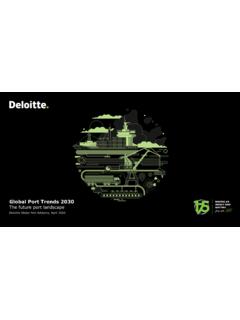Transcription of What is the future of work? - Deloitte
1 FEATURE. what is the future of work ? Redefining work , workforces, and workplaces Jeff Schwartz, Steve Hatfield, Robin Jones, and Siri Anderson PART OF A Deloitte SERIES ON THE future OF work . what is the future of work ? Rethinking work , workforces, and workplaces Forces of change are affecting three major dimensions of work : the work itself, who does the work , and where work is done. To create value from these changes, organizations should take a broader perspective. T. HE future OF work : what does this term work with implications for individuals, businesses, really mean? Much discussion has focused and society. on artificial intelligence and whether or not We define the future of work as a result of many robots will take our jobs, but cognitive technologies forces of change affecting three deeply connected are only one aspect of the massive shift that is under dimensions of an organization: work (the what ), way.
2 To understand what 's going on and, more im- the workforce (the who), and the workplace (the portantly, what we can do about it, it's important to where) (figure 1). consider multiple converging trends and how they The new realities created by these forces of are already fundamentally changing all aspects of change present us with complex questions to FIGURE 1. The future of work encompasses changes in work , the workforce, and the workplace Current work options future work options Workforce 2 Who can do the work ? With new talent platforms and contracts, who can do the work ? How do we leverage the continuum of talent from full-time, to managed services, to freelancers, gig workers, and crowds? Talent category 3. work Workplace 1 what work can be automated? 3 Where is the work done?
3 With new combinations of collabora- With increasing robotics, cognitive, tive, teaming, and digital reality and AI technologies, what work can be technologies, how are workplaces and done by and with smart machines? work practices reshaping where and when work is done? 1 2. Automation level Physical distance Source: Deloitte analysis. Deloitte Insights | 2. what is the future of work ? Rethinking work , workforces, and workplaces consider including ethics around human-machine shifting our understanding of work from task com- collaboration, how we plan for 50 60-year careers, 1. pletion to problem-solving and managing human and how we unleash organizations through a con- Technology has already begun to tinuum of talent sources. As Thomas Friedman has change the way we organize tasks into jobs: For observed, what 's going on is that work is being dis- example, robotics and robotic process automation connected from jobs, and jobs and work are being have transformed manufacturing and warehouses, disconnected from companies, which are increas- and digital reality technologies are helping workers ingly becoming platforms.
4 2 transcend limitations of distance and who is as- In this article, we provide an overview of the signed to which task. According to the World forces of change that are driving the evolution Economic Forum, the division of labor between of work , workforces, and workplaces, and offer a people and machines is expected to continue to perspective on how organizations should begin to shift toward machines, especially for repetitive respond to the new challenges unfolding. Orga- and routine That could eliminate upward of nizations today appear to have an unprecedented 14 percent and disrupt 32 percent of today's jobs, window of opportunity to shape what ultimately according to the Organization for Economic Coop- becomes the future of work . eration and Development (OCED).
5 6. However, there is evidence that these tech- nologies could be used to augment the efforts of the work : what will the workforce rather than replace them in fact, in a work look like? 2018 report the World Economic Forum projected that while nearly 1 million jobs may be lost, another This isn't the first time that the western society million will be The jobs of the future has completely changed its cultural idea of work . In are expected to be more machine-powered and the preindustrial economy, work was synonymous data-driven than in the past, but they will also likely with craftsmanship, the creation of products or require human skills in areas such as problem- the delivery of complete outcomes. The craftsman solving, communication, listening, interpretation, took end-to-end responsibility for delivering the and design.
6 As machines take over repeatable tasks product or outcome a cobbler, for instance, would and the work people do becomes less routine, roles do everything from measure the customer's feet to could be redefined in ways that marry technology make final adjustments in the finished pair of shoes. with human skills and advanced expertise in inter- The industrial revolution changed this conception pretation and Techniques such as design of work , as industrialists realized that products thinking can help organizations define roles that could be manufactured faster and cheaper if end- incorporate the new types of capabilities, skills, ac- to-end processes were atomized into repeatable tivities, and practices needed to get the work done. tasks in which workers (and, later, machines) could To make all of this happen successfully, we will specialize.
7 The notion of a job became that of a likely need to change the way we conceive of work collection of tasks, not necessarily related to each and develop the training our workforce needs to other, rather than an integrated set of actions that take on these new roles and assignments. Other- delivered a complete product or wise, we could find ourselves weighed down trying Now, as we step rapidly into the cognitive revo- to apply legacy concepts and skills onto the new lution, we once again appear to be redefining work and quickly emerging world of human-machine to create valuable human-machine collaborations, collaboration. 3. what is the future of work ? Rethinking work , workforces, and workplaces Workforce: Rethinking and what type(s) of employment are best suited to talent models obtain the creativity, passion, and skill sets needed for the work at hand.
8 Orchestrating this complex Not only have workforce demographics changed use of different workforce segments might require over the last 30 years collectively making the new models. It could fundamentally change our workforce older9 and more diverse10 but the very view of the employee life cycle from the traditional social contract between employers and employees attract, develop, and retain model to one where the has altered dramatically as Organizations key questions are how organizations should access, now have a broad continuum of options for finding curate, and engage workforces of all types (see workers, from hiring traditional full-time em- the sidebar, Beyond the employee life cycle ). ployees to availing themselves of managed services Organizations have an opportunity to optimize and outsourcing, independent contractors, gig the organizational benefits of each type of talent workers, and crowdsourcing.
9 These newer work - relationship while also providing meaningful and force types are available to solve problems, get engaging options for a wide variety of worker needs work done, and help leaders build more flexible and and motivations. However, making the most of the nimble organizations (figure 2). Alternative workers opportunity could require a complete rethinking of are growing in number; currently, 35 percent of talent models in a way that allows organizations to the US workforce is in supplemental, temporary, carefully match people's motivations and skills with project, or contract-based This percentage is the organization's work needs. growing as well for example, freelance workforce is growing faster than the total workforce, up percent compared to percent of all Workplace: Rethinking As labor-sourcing options increase, it opens up where work gets done the possibility for more efficiency and creativity in composing an organization's workforce.
10 But As the who and the what of work shift, so with more options often comes more complexity. does the workplace. Where once physical prox- Employers should not only consider how roles are imity was required for people to get work done, crafted when pairing humans with machines, but the advent of digital communication, collabora- also the arrangement of their human workforce tion platforms, and digital reality technologies, FIGURE 2. The talent market covers a spectrum of worker types and work arrangements Traditional Open Best for function-speci c work Best for task-speci c work Open talent continuum Joint venture Contractors employees Organization's Managed service Gig workers Crowd employees providers Source: Deloitte analysis. Deloitte Insights | 4. what is the future of work ?
















